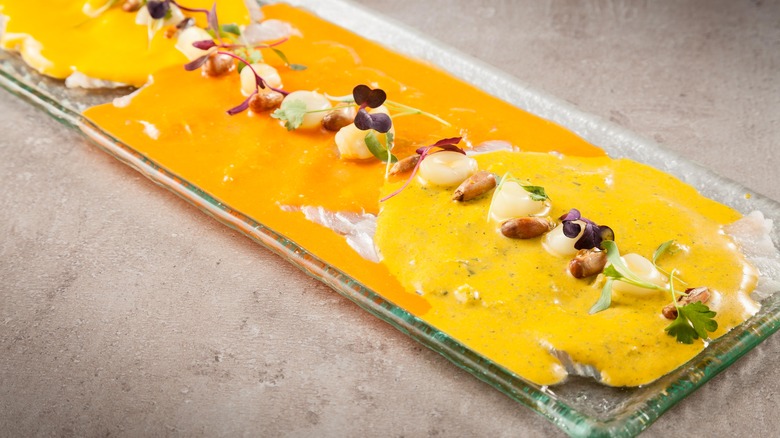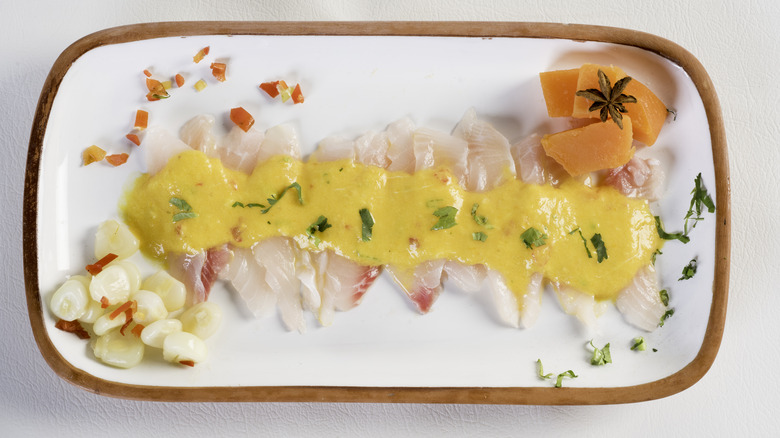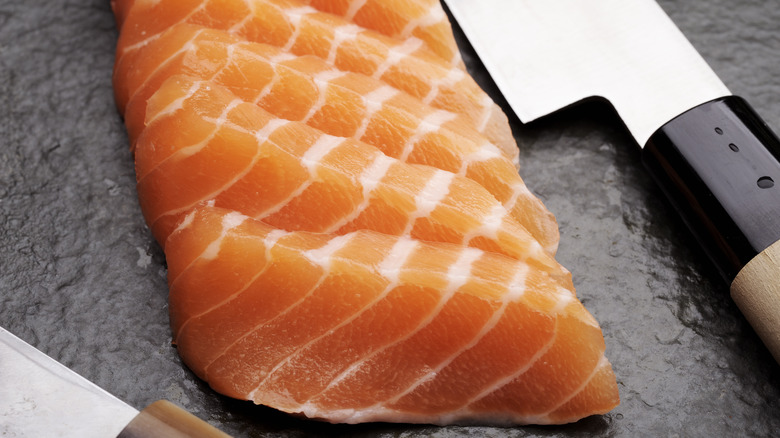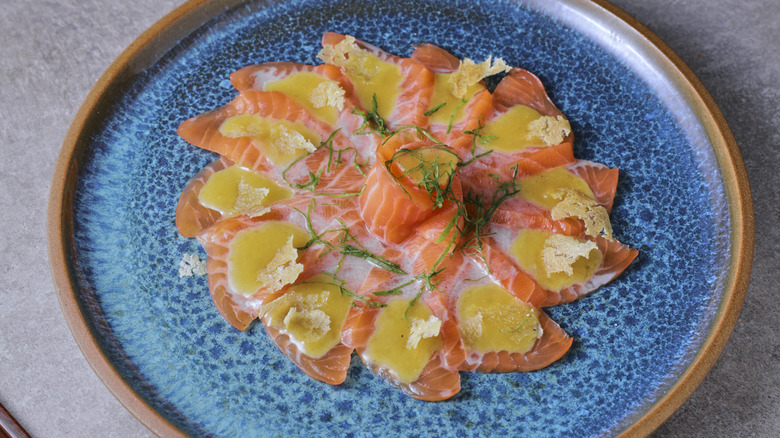Tiradito: The Citrusy Ceviche Style To Make Fresh Tuna Shine
When it comes to eating raw fish, Japanese cuisine is likely the first thing that comes to mind. The island nation has mastered the preparation of raw seafood, using deft techniques to highlight the best of the ocean's offerings.
So when a wave of Japanese immigrants made their way to Peru in the 19th century, they carried along such culinary traditions. Amongst many other creations, the tiradito was born. Made with sliced pieces of fresh tuna or other fish, the dish is both parts sashimi and ceviche. A tangy and spicy sauce comprised of ají amarillo and limes submerges the tuna but, unlike other ceviches, doesn't marinate it. The plate gets a sprinkling of more chilies, as well as choclo and sweet potatoes — two Peruvian staples.
All sounds delicious, right? Best of all, such a dish highlights the freshness of the fish, so it doesn't get lost in the marinade. A delicious method to showcase that cut of high-quality yellowtail from the market.
Origins of tiradito
Tiradito is a stalwart on menus featuring Nikkei cuisine — a fusion of Japanese and Peruvian techniques. The food style was initiated in 1889 when 7,000 Japanese immigrants arrived just outside of Lima for new economic prospects. The migrants combined local ingredients with Japanese methods — like a propensity for fresh seafood. In fact, their arrival kicked off the enjoyment of raw fish in the South American nation. Previously, Peruvians only cooked or cured foods from the sea.
Tiradito borrows from the sashimi style, slicing the fish into thin strips rather than cubes. This likely gives the dish its name — a shortening of the word estirado, meaning stretched in Spanish. Atop the Japense-style sliced fish, the dish incorporates Peruvian ingredients like lime, cilantro, and aji peppers. Such an intertwining of cultures upholds the Nikkei legacy, which also exists in neighboring Chile and Brazil. Propped by dishes like the tiradito, Nikkei cuisine is achieving widespread popularity through the likes of Nobu, and Maido, a Lima restaurant ranked highly in the World's 50 best.
How tiradito is made
Preparing tiradito starts with a careful selection of fish. Tuna, especially yellowfin, is a popular starting point, as is white-fleshed fish popular in Peru, like corvina and bass. Salmon works, too; just make sure the choice is sashimi grade to prevent illness.
After the fish is sliced into thin slivers, it's laid out on a plate. Meanwhile, the sauce is assembled in the blender. Cilantro, garlic, ají amarillo, and occasionally ginger are combined with many juiced key limes — typically around eight to 10. The pepper paste provides body to the sauce, so don't skimp out over fear of heat. The result is spooned over the fish.
Tiradito can be covered in a variety of toppings, with large-kernel Peruvian corn variation choclo, and sweet potatoes common choices. These vegetables are boiled so that they're edible. For extra heat, additional ají limo may also be sliced on top. Tons of tiradito variations exist, from pickled red onion toppings to a passionfruit sauce. Some even substitute the fish for other seafood, like scallops. As a dish founded upon experimentation, innovative renditions are common.
How tiradito is served
Unlike other ceviches, which are marinated, tiradito comes out ready to eat immediately after preparation. It's usually made to order and served as an appetizer, quickly eaten in minutes. It's especially popular as a summer dish, a method to take away from the heat. Don't expect any chips or other nibbles to accompany the fish — it's eaten with a fork.
The dish is on nearly every menu in Nikkei restaurants. A cornerstone of Lima's dining scene, these establishments range from casual to upscale, with accompanying renditions of the dish. Expect to see it in settings like the raw bar La Mar Cebichería which also serves ceviches and nigiri. Alternatively, the dish is given a reinvented take at Matria as part of a multi-course meal. Just don't expect to find the tiradito streetside — it's eclipsed by ceviche with its ease of marination. Nevertheless, it's a delicious seafood dish worth seeking out.



